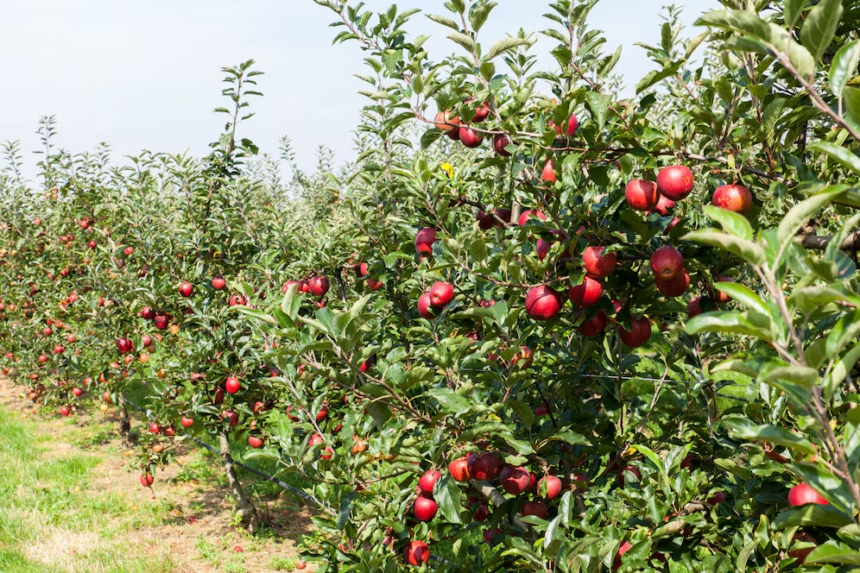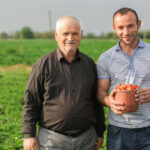South Africa is home to a variety of climates and regions that allow for the cultivation of different types of fruit. Among the most popular and widely cultivated fruits is the apple, which thrives in colder climates. For those looking to grow apples in South Africa’s colder regions, it’s essential to understand the unique conditions required for successful apple farming. In this guide, we’ll explore everything you need to know about growing apples in cold regions of South Africa, from choosing the right variety to harvest time.
1. Understanding the Ideal Climate for Apple Farming in Cold Regions
Apples are best suited to temperate climates, and South Africa’s cold regions, such as Ceres Valley, Elgin, and the Langkloof, provide ideal growing conditions. Apples require a period of winter chill to break dormancy and ensure proper flowering and fruit set. Here’s what you need to consider regarding climate:
- Winter Chill Hours: Apples need between 800 and 1,500 chilling hours (temperatures between 0°C and 7°C) during the winter months. This period helps the trees go dormant and ensures good fruit production during the growing season.
- Summer Temperatures: While apples need cold winters, they also require warm, but not excessively hot, summers for the fruit to ripen. Daytime temperatures between 18°C and 24°C are ideal for optimal apple growth.
- Frost: Apples are sensitive to frost, especially during the early spring when buds are forming. It’s important to plant apples in areas that are less prone to late spring frosts or invest in frost protection methods such as wind machines or frost nets.
2. Choosing the Right Apple Varieties for Cold Regions
Choosing the correct apple variety is crucial for success. In colder regions of South Africa, certain apple varieties perform better than others due to their chilling requirements and adaptability to the climate.
- Popular Varieties for Cold Regions:
- Golden Delicious: Known for its sweet flavor and yellow skin, this variety thrives in colder regions and is a common choice among South African apple growers.
- Royal Gala: This variety produces sweet, crisp apples with red skin and is well-suited for the cooler climates of South Africa.
- Cripps Pink (Pink Lady): A popular variety that combines a sweet-tart flavor, Cripps Pink apples do well in colder regions and are known for their pinkish-red color.
- Granny Smith: A green apple variety that is ideal for colder climates due to its resistance to cold stress and its crisp, tangy flavor.
When selecting varieties, consider factors such as market demand, fruit storage requirements, and your specific region’s chill hours.
3. Preparing the Soil for Apple Orchards
Apple trees require well-draining, fertile soil for optimal growth. Before planting your apple orchard, it’s essential to prepare the soil to ensure healthy trees and a good harvest.
- Soil Testing: Conduct a soil test to determine the pH, nutrient levels, and drainage capabilities of the soil. Apples prefer slightly acidic soil with a pH of 6.0 to 6.5. If the soil is too acidic, lime can be added to raise the pH.
- Soil Preparation: Use organic matter such as compost or well-rotted manure to improve soil fertility. Additionally, it’s essential to ensure proper drainage, as waterlogged soil can lead to root rot. Raised beds or mounded rows can help improve drainage in areas with heavy or clayey soils.
- Fertilization: Apply balanced fertilizers to promote healthy tree growth. Typically, apples require nitrogen (N), phosphorus (P), and potassium (K) to grow strong. However, the specific fertilizer needs depend on the soil test results.
4. Planting Apple Trees: Timing and Method
Timing is key when planting apple trees, as you need to ensure that they are planted at the right time to establish a strong root system before the cold weather sets in.
- Best Planting Time: The ideal time to plant apple trees in cold regions of South Africa is in the early spring or late winter when the trees are still dormant. This gives them time to establish roots before the heat of summer arrives.
- Planting Method: Apple trees should be spaced about 4 to 6 meters apart to give them room to grow. Plant the trees in holes that are about 60 cm deep and wide, ensuring the root system is well-covered but not buried too deeply. Make sure the graft union (the swollen area where the rootstock meets the scion) is above the soil surface to avoid potential disease issues.
5. Watering and Irrigation for Apple Trees
Apple trees require consistent watering, especially during the early years of growth. However, it’s essential not to overwater, as apples are susceptible to root rot in waterlogged soil.
- Irrigation System: Drip irrigation is an excellent choice for apple trees as it ensures deep, consistent watering and minimizes water wastage. Set the system to water the trees early in the morning to prevent fungal diseases caused by excessive moisture overnight.
- Watering Frequency: During the growing season, apple trees generally require watering every 7 to 10 days. However, during dry spells or hot weather, they may need more frequent watering. Reduce watering during the winter months when the trees are dormant.
6. Pruning Apple Trees
Pruning is essential for maintaining a healthy apple orchard and ensuring high-quality fruit production. Regular pruning encourages good air circulation, improves light penetration, and promotes the growth of productive fruiting wood.
- Pruning Schedule: Apple trees should be pruned in the winter when they are dormant. This allows the tree to focus its energy on producing fruit during the growing season.
- Pruning Techniques: Remove any dead, diseased, or damaged branches. Thin out crowded areas to improve air circulation and light exposure. Maintain the tree’s shape by cutting back long or weak growth, ensuring a strong central leader (main trunk) and evenly spaced branches.
7. Pest and Disease Management
Like all fruit crops, apple trees are susceptible to a variety of pests and diseases. Early intervention is essential to prevent crop loss.
- Common Apple Pests: Aphids, codling moths, and apple maggots are some of the pests that may attack apple trees. Regularly inspect your trees for signs of pests and use organic or chemical treatments as necessary.
- Diseases: Apple scab, powdery mildew, and fire blight are common diseases that can affect apple trees. Fungicides can be used to manage these diseases, and preventive measures such as proper spacing and good air circulation help reduce the risk.
- Integrated Pest Management (IPM): Implementing an IPM strategy is crucial for effective pest control. This includes using natural predators, crop rotation, and reducing pesticide use to minimize environmental impact.
8. Harvesting Apples
After investing time and effort into growing your apples, the harvest season is the reward. Apples are generally ready for harvest when they reach full color and the fruit begins to separate easily from the tree when lifted gently.
- Harvesting Time: Depending on the variety, apples in cold regions of South Africa are typically ready for harvest in late summer to early autumn (February to April). Make sure to test the fruit by checking its firmness and taste.
- Harvesting Method: Gently twist the apples off the tree to avoid bruising. Use a picking bag or bucket to collect the fruit, and try to handle them with care to maintain their quality.
9. Post-Harvest Storage and Marketing
Once harvested, apples need to be stored properly to maintain their freshness and prevent spoilage.
- Storage Conditions: Store apples in a cool, dry place, ideally in a refrigeration unit or cold room with controlled temperature and humidity. The optimal storage temperature for apples is between 1°C and 4°C.
- Marketing: If you plan to sell your apples, consider local markets, grocery stores, and supermarkets. You can also explore exporting your apples to international markets if you’re growing large quantities.
Growing apples in the cold regions of South Africa can be a rewarding and profitable venture. By understanding the climatic conditions, selecting the right varieties, preparing your land, and using proper techniques for planting, watering, pruning, and pest management, you can achieve a successful apple harvest. With careful attention to detail and a solid plan, apple farming in South Africa’s colder regions can yield delicious, high-quality fruit for local and international markets.







